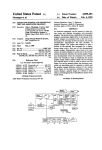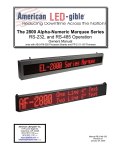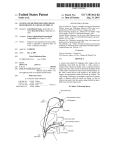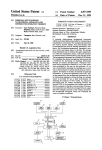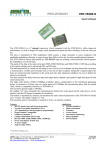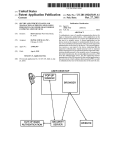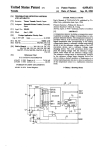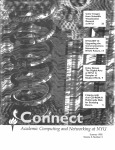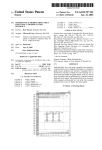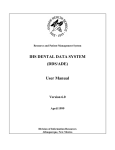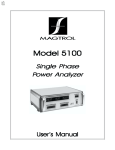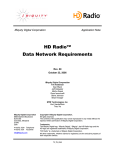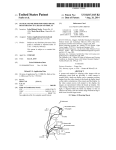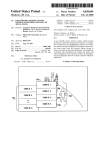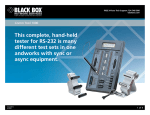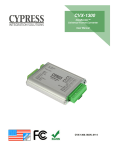Download Microprocessor controlled security system for computers
Transcript
llllllllllllllllllllllllllllllllllllllllllllllllllllIllllllllllllllllllllll US005187352A United States Patent [191 [11] [45] Blair et al. [54] MICROPROCESSOR CONTROLLED Patent Number: _ Date of Patent: 5,187,352 Feb. 16, 1993 SECURITY SYSTEM FOR COMPUTERS Apple Computer Inc., AppleTalk Personal Network, Disclosure, Apr. 1986. [76] Inventors: William Blair, 1154 W. Lunt, Apt. 302, Chicago, Ill. 60626; Stanley J. Brooks, PO. Box 906, Douglas, Ga. Sun Micro Systems, Tech Note 1010, Network Hard ware and Cabling Topologies, Aug. 1989, pp. 1-6. Sun Micro Systems, Tech Note 1011, Cabling with TOPS and Ethernet, Aug, 1989, pp. l-2. 31533 Centrams Systems West, Inc., Manual, 1987. Recommac Corp., New Product Release, Model Ver sions v. H21, Dec. 18, 1989, pp. l—-4. Recommac Corp., New Product Release, Model Ver [21] Appl. No.: 597,422 Oct. 15, 1990 1221 Filed: sions vHl.0.1 and Model Versions vl-l2.l, Sep. 19, 1989. Recommac Corp., Brochure, Jun. 6, 1990. Recommac Corp, Brochure, Aug. 12, 1990. Motorola, Microprocessor, Microcontroller and Pe Related US. Application Data ' [63] Continuation-impart of Ser. No. 297,302, Jan. 3, 1989, abandoned. [51] [52] Int. Cl.5 ............................................. .. G06K 5/00 [58] Field of Search ................... .. 235/382, 382.5, 487; ripheral Data Book; MC68701U4 technical disclosure; MC68701 technical disclosure; MC6801 and MC6803 technical disclosures (1988). Primary Examiner-Harold Pitts Attorney, Agent, or Firm-Allegretti & Witcoff, Ltd. US. Cl. ............................... .. 235/382; 235/382.5; 235/487; 380/25 340/825.3l; 902/22; 380/25 [56] [57] ABSTRACT A microprocessor controlled computer security system References Cited U.S. PATENT DOCUMENTS 3,896,266 4,800,590 7/1975 Waterbury . l/l989 Vaughan . 4,839,640 l/l989 is disclosed that provides for controlled access to single or multiple components of a computer system. The security system includes a magnetic card reading and encoding device that reads component access and time Ozer et al. ........................ .. 235/382 OTHER PUBLICATIONS allotment data from a magnetically encoded card. A George Sadowsky, A Proposed Plan for Academic Computing, Spring 1989, pp. 2-13. Byte Magazine, L. Brett Glass, Part 1 The SCSI Bus, Feb. 1990, pp. 267, 268, 270, 271, 272, 274. Byte Magazine, L. Brett Glass, Part 2 The SCSI Bus, microcontroller, which incorporates a microprocessor, processes the data read by the reading and encoding device and responsively issues enable or disable signals through a component interface circuit to the computer system component or components to be enabled or disabled. The components to be enabled may be the video display device, hard disk drive, or external cen Mar. 1990, pp. 291-296. POWER R, Video Products and Price Information, tral processing units of slave computers. The security system further includes audio and visual indicators that provide system and component status information. The Aug. 1988. Xico, lnc., Magnetic Stripe Card Terminal Data Sheet and Instruction Manual, Jun. 1986. magnetic card reading and encoding device is operable Xico, Inc., Drawings, Jan. 25, 1985. in a program mode, wherein the magnetic card is pro grammed with component access and time data, and a Xico, Inc., Model 2165 RS-232C Controller For Series 6500 Swipe Reader/Encoders User’s Manual, Mar. 1986. Mac Users Magazine, Kurt VanderSluis, The Exorcist, Part II, May 1989, pp. 230, 232. reading mode wherein the reading and encoding device reads and updates the access and time data on the card. 26 Claims, 5 Drawing Sheets LEOS 322 /4 70 CARD RUDE“ ENCODER '6 1 Power: menace L 46 ‘8/ mocessoa 22 24 /8~/ \g PERIPHERAL 25 \CRVS‘TAL \. m 1 z” "mam 8 Nil/DR /30 EXTERNAL WITORS '1 -— @mm ‘86 '2 4/ AUDIO imam: mu ROM '3‘ if US. Patent Feb. 16, 1993 Sheet 2 of 5 5,187,352 '3PCSLAVE 1 5,187,352 2 Computer-owning institutions could, of course, place MICROPROCESSOR CONTROLLED SECURITY SYSTEM FOR COMPUTERS each computer within a locked'room (with different rooms having different combinations of peripherals) and allow students or other users access to those rooms only for limited and carefully controlled times. How 5 This is a continuation-in-part of application Ser. No. 297,302, ?led Jan. 13, 1989, and now abandoned. ever, a simple locked room is often inadequate to pro vide proper security for personal computer data and BACKGROUND OF THE INVENTION makes accurate accounting of the individuals who use computers and their peripherals, and the amount of use A portion of the disclosure of this patent document contains material which is subject to copyright protec 0 by each individual difficult. Such methods are cumber tion. The copyright owner has no objection to the fac simile reproduction by any one of the patent disclosure, as it appears in the Patent and Trademark Office patent ?les or records, but otherwise reserves all copyright rights whatsoever. A. Field of the Invention The present invention relates generally to a micro processor controlled security system for computers, especially personal computers. More particularly, it relates to a computer security system accessed by mag netically encoded cards that allows control of personal computer access and time usage, internally recorded data and attached peripheral devices. B. Description of Related Art With personal computers and their applications be coming more commonplace, an increasing number of such computers are being placed in multi-user environ ments. For example, universities and other educational some and, in any event, unlikely to be followed with the consistency necessary for accurate accounting or cost charging. Another potential multi-use circumstance for per sonal computers is in a classroom environment, where one “master" computer, associated with an instructor, displays its data on the screens of a number of “slave” computers, each associated with one or more students. These screens and their internal hard drives can also be driven-by the “master computer” independent of indi vidual computers. In that circumstances, the instructor often wants control over the activation of the individual computers or screens so as to fully control the lecture or other educational environment. Aside from physically disabling the “slave” computers, hard drives, or screens by, for example, disconnecting the equipment from its power source, few methods have been traditionally available for allowing instructors to have such control. Due to the need for security for personal computer institutions often give their students access to many systems, it is not surprising that considerable effort has personal computers, and allow the same computer to be been made in the prior art to meet the needs of comput used by any of a number of different students. Typi~ er-owning institutions. Simple password techniques are cally, a university or other institution might make per perhaps the most familiar, where access is gained by the sonal computers available in a library for the use of user by entering a password into the computer. Pass students who are studying or conducting research. 35 word generating machines combined with computer Similarly, businesses will often make one or more interfacing devices are also known int he art, one exam personal computers available for use by multiple em ployees, who perform the same or similar tasks, or who may even perform dramatically different tasks. In either circumstance, the computer may have any of a variety of built-in or peripheral features, such as disk drives ple being U.S. Pat. No. 4,800,590 issued to Vaughn. Other security techniques include call and call back systems, security by encoding messages and data, and “trapdoor” encryption schemes. However, such com puter access and security techniques each have their (?oppy disks, hard disks, CD ROM’s, etc), printers, limitations. Most do not provide for limited time access, and some are too expensive or impractical for personal vices, or video devices. computers or personal computer networks. Addition When personal computers are made available for use 45 ally, many prior art methods are not suitable for selec by multiple individuals, the organization owning the tive access to peripheral devices linked together optical scanners, modems, FAX machines, MIDI de computer often wants to maintain control of the access to those computers, and their peripherals. Thus, educa tional institutions and businesses may keep their per sonal computers within locked rooms and allow entry into the room only by those with authorization to access through a peripheral data bus to a master computer. Accordingly, it is an object of this invention to pro vide a system for controlling access to personal com puter and peripheral devices to authorized users. It is also an object of this invention to provide a com puter security system that is suitable for personal com puters, and that is both practical and of reasonable cost. A further object of this invention is to provide secu often seek to allocate the expenses for each computer’s use, either in the organization’s accounting procedures 55 rity for data that is held within such personal comput the computers. Organizations having such multi-user computers or through actual charges to users. Such charges are either made directly to the individual users, or are allo ers, when the data is held within internal or physically attached hard disks or other data storage devices. Yet another object of this invention is to provide a cated for accounting purposes in accordance with the means for accurately recording and accounting for the tasks performed by those individuals. Thus, a university may keep track of the students who use computers and 60 time used by each computer users on the equipment. A related object is to provide an ability to disable the their peripherals by academic department to determine whether more expenses associated with personal com operation of personal computers when their operation is not authorized, or when the elapsed time used by a computer user reaches a predetermined time limit. other, or the university may require students or other users to “pay by the hour” for their actual use of com 65 SUMMARY OF THE INVENTION puter time. Likewise, organizations may want to limit These and other objects of this invention are obtained access to certain costly peripherals, such as laser print by providing a microprocessor controlled security sys ers. Business environments have similar requirements. puters should be allocated to one department or an 3 5,187,352. 4 displays, data storage devices, accessories, and periph FIG. 4 is a ?ow diagram depicting the general opera tion of the preferred embodiment of the present inven erals. The security system includes a magnetic card tion. reading and encoding device for reading input signals FIG. 5 is a detailed circuit diagram of a preferred embodiment of the present invention shown in FIG. 1; FIG. 6 is a detailed circuit diagram of an alternative embodiment of the present invention. tem for controlling access to personal computer video form a magnetically encoded card which includes at least one magnetically encoded data track. The security system also includes a microcontroller that processes the input signals read by the magnetic card reading and encoding device, and responsively provides component enable and disable signals for computer video displays, DETAILED DESCRIPTION OF THE _ PREFERRED EMBODIMENT Referring to FIG. 1, the elements of the microproces data storage device, computer accessories, and com puter peripherals. A component interface is further sor controlled security system 10 can be seen in block provided which enables and disables at least one com ponent of the computer system in response to the com diagram form. The system 10 includes a magnetic card reading and encoding device 12 which reads input sig ponent enable and disable signals provided by the mi crocontroller. The security system further includes nals from a magnetically encoded card 14 which in cludes at least one magnetically encoded data track 16. A microcontroller 18 which includes a microprocessor indicators which indicate the status of the security sys processes input signals read by the magnetic card read tem and the components in response to indicator signals ing and encoding device 12, and responsively provides from the microcontroller. The microcontroller and reading and encoding de 20 component enable or disable signals to a component interface 20 for enabling or disabling various compo vice provide the capability to program time and compo nent access data onto the magnetically encoded card. The card, once programmed, is inserted into and out of nents of a computer system such as a printer 22, scanner 24, MIDI 26, disk drive 28, or internal or external video monitors 30. the reading and encoding device to gain access to the The microcontroller 18 further issues indicator sig component that corresponds to the data track that is 25 nals to various indicators, such as LED’s 32 for indicat programmed. Subsequent insertion and removal of the ing to the user the status of the components and the card disables the component, and the residual time re maining to the user is written onto the card as it is with drawn. Thus, the security system controls access to compo nents of the computer system depending on the data that is programmed onto the magnetically encoded card. The computer-owning institution has control of access to computers and peripheral devices depending security system. The operation of the indicators 32 is controlled by the microcontroller 18. Audio indicators are provided through an audio circuit 34 which is also controlled by the microcontroller 18. The microcon~ troller 18 provides a ?rst indicator signal to the audio circuit 34 when a certain fraction of computer access time remains allocated on the time ?eld, for example, on how it chooses to program and distribute the cards. 35 l/60 (at one minute when 60 minutes was originally The system is practical and of relatively low cost as well. Control over access to internally stored data is con authorized). A second indicator signal is provided when a second fraction, say l/ 120, of computer access time remains allocated in the time ?eld. The indicators give notice to the user that access time is about to expire, and trolled by programming access and time data onto a card that is designated a hard disk drive card. Similarly, 40 thereby giving the user a chance to save his or her tiles. control over peripheral devices is achieved by pro~ gramming the card to gain access to a peripheral device The microcontroller 18 has a clock crystal circuit 36 for measuring time and providing clock inputs to the over the peripheral data bus. microcontroller. The microcontroller 18 also is pro vided with a RAM/ROM computer memory 38 that Recording the accounting for time usage is provided by selecting the amount of time to be programmed onto 45 stores the system operating code and transitory data. In one possible embodiment, the magnetic card read the time ?eld of the data track on the card. When the ing and encoding device 12, microcontroller 28, mem authorized amount of time is nearly up, the user is ory device 38 and interface 20 are incorporated into the alerted by the indicators (audio and/or visual) and the housing of a personal computer, but they may be posi component is disabled at the expiration of the autho 50 tioned external of the computer. In the preferred em rized time. bodiment, the security system is installed in a host or Other features, objects, and advantages of the inven master personal computer manufactured by Apple tion will become apparent from the following detailed Computer, and controls access to peripheral devices description of the preferred embodiment and explana and remote personal computers through a bus interface tion of practice and use of the system described below. in the external peripheral interface 20. BRIEF DESCRIPTION OF THE DRAWINGS Referring again to FIG. 1, the magnetic card reading and encoding device 12 is a standard “off-the-shelf’ In the detailed description of the preferred embodi magnetic card reader/encoder. In the preferred em ment and alternative embodiments which follows, refer bodiment, the reading and encoding device 12 is the ence will be made to the accompanying drawings wherein like numerals in the text refer to like elements 60 XICO, Inc. Model 7702SA insertion card reader/en coder peripheral unit, available from XICO, Inc. 9737 of the various drawings, and in which: FIG. 1 is a general block diagram of the microproces Eton Avenue, Catsworth, Calif. 91311. The microcontroller 18 in FIG. 1 is preferably a sor controlled computer security system of the present Motorola MC68A70lS Controller lOO microprocessor. invention; FIG. 2 is an illustration of a bidirectional magneti 65 The microcontroller 18 is programmed with resident cally encoded card employed in the present invention; software (see Appendices) for controlling operation of FIG. 3 is a diagram depicting the environment in which the security system of FIG. 1 may be employed; the computer security system 10. The particular amount of time to be programmed on the cards and the choice 5 5,187,352 6 by changing the software for the microcontroller. Referring now to FIG. 2, the magnetically encoded ual computer access time remaining in the time ?eld upon disabling the hard disk drive 28 by a subsequent insertion and retraction of the card 14 into and out of card 14 is shown as comprising a bidirectional card that includes two data tracks 40 and 42. The data tracks 40 embodiment, the time ?eld included on the data track of which components to be accessed by the card is made the reading and encoding device 12. In the preferred for enabling and disabling video display 54 is not re duced by the computer security system, as is the time ?eld included on the data track for enabling the dis abling hard disk drive 28. A random number (up to 8 and 42 are independently read by the magnetic card reading and encoding device 12 depending on the direc tion in which the card 14 is inserted into the device 12. The data tracks 40 and 42 are encoded to enable or disable one or more computer system components or bed digits) is written to a card that has successfully enabled a component before the card is completely withdrawn. This insures another card cannot be used to external peripheral accessories, as will be explained below. The card 12 may include a pair of additional data tracks on its reverse side for a total of four data tracks. Additionally, data tracks 40 and 42 may include a time ?eld for computer access time accounting purposes. The data tracks 40 and 42 of the magnetically encoded disable the component. In an alternative embodiment, the data tracks on the card 14 may be encoded to enable and disable the disk drives or the video displays of a plurality of slave com puters 60 or monitors 62, or any combination of the card 14 are encoded by an authorized system operator by activating a switch 46 connected to the microcon external peripheral equipment stated above. Video dis play monitors may be controlled by controlling the troller 18 (FIG. 1) on selected security systems. Referring now to FIG. 3, the computer security sys 20 video signal, or the video display power supply. Addi tionally, the slave computers 60 may also include a tem of the present invention is shown installed in a host or master computer 50. The magnetically encoded card 14 is inserted through a slot 52 to be read by the mag computer security system 10 having magnetically en coded cards 64 encoded to enable and disable computer netic card reading and encoding device 12 (FIG. 1) built components and external peripheral equipment in a into the host computer 50. Depending on how the card 14 is encoded, the video display 54 may be disabled or manner as state above with regard to the host computer enabled, the internal disk drives (not shown) may be Security System Operating Flow Diagram 50. disabled or enabled, or various peripheral devices such The operation of a preferred embodiment of the com as a printer 22, scanner 24 or other peripherals 58 may be enabled or disabled. It is also possible to enable or disable slave PCs 60 or remote central processing units linked through a peripheral bus to the host computer 50. puter security system is illustrated in the flow diagram of FIG. 4. For simplicity, the external peripheral inter faces to be enabled or disabled by the security system are the video display and the hard disk drive of the host The peripheral bus referred to herein will normally be computer. the SCSI (Small Computer Systems Interface) bus com mon to personal computers. In the preferred embodiment, the security system provides restricted access to host computer 50 by con trolling the video display 54 and the hard disk drive 28 (not shown in FIG. 3). Video display 54 is enabled by inserting and retracting the magnetically encoded card 14 into and out of the reading and encoding device 12 such that data track 40 (FIG. 2) is read, and the hard disk drive 28 is enabled by inserting and retracting the ' 35 Power is applied to the computer security system upon activation of the host computer at Step 1. The computer security system performs a hardware test at Step 2. The test is limited to security system circuitry, aside from the shot computer power supply from which it derives its power. A computer security system hard ware failure is indicated at Step3. The computer secu rity system indicates that the card reading and encoding device is waiting to read a magnetized card at Step 4. A magnetically encoded card is inserted into the card magnetically encoded card 14 such that data track 42 is read. The video display 54 and the hard disk drive 28 45 reading and encoding device at Step 5. The computer security system determines whether the magnetic card are disabled by a subsequent insertion and retraction of data track is invalid or unreadable at Step 6 upon inser data tracks 40 and 42 into and out of the reading and encoding device 12. In the preferred embodiment, data tracks 40 and 42 include a time ?eld allocating a predetermined amount of computer access time. The time ?eld included in the tion of the card into the card reading and encoding device at Step 5. An unreadable card has either the wrong address code or has had its magnetic ?eld erased. The computer security system determines whether the hard drive data track or the video display data track has been inserted into the card reading and encoding device at Step 7. Insertion of the video display data which hard disk drive 28 is enabled. Upon expiration of the access time allocated by the time ?eld, hard disk 55 track on the card into the card reading and encoding device will prompt the computer security system to drive 28 will be disabled by security system 10. How determine whether the video signal is enabled at Step 8. ever, security system 10 provides an audio and visual If the video is not on, upon retraction of the card from warning indicating when there are approximately 2 and the card reading and encoding device at Step 9, a dis 1 minutes of computer access time remaining in the time abled video signal is enabled at Step 10. The computer ?eld, thereby allowing the user to save any data before security system also indicates that the video display has hard disk drive 28 is disabled. Additionally, upon en been enabled. Upon completion of Step 10, the com abling the hard disk drive 28 by inserting and retracting puter security system indicates that the card reading the card 14 into and out of the reading and encoding and encoding device is awaiting to read a card at Step 4. device 12, the device 12 zeros the time ?eld on the card If the video is on, upon retraction of the card from the 14 as the card 14' is retracted from the device 12, 65 card reading and encoding device at Step 11, the video thereby preventing the card 14 from being used to ac signal is disabled at Step 12. The computer security cess another computer protected by a similar computer system also indicates that the video display has been security system. The card 14 is credited with any resid data track for enabling and disabling the hard disk drive 28 is reduced an amount proportional to the time during 7 5,187,352 8 Step 12. Upon completion of Step 12, the computer stated previously, is the Motorola MC68A701S Con troller 100. The microcontroller 18 is a 40 pin device, security system indicates that the card reading and en coding device is waiting to read a card at Step 4. which contains 2K bytes of electrically programmable read only memory (EPROM) and 128 bytes of random disabled. The time field on the card is also updated in Insertion of the hard drive data track on the card into the card reading and encoding device will prompt the computer security system to determine whether the hard drive is enabled at Step 13. If the hard disk is access memory (RAM). Of course, other microcontroll ers with different size memories may be suitable for particular applications. The'control software lies in the on-chip EPROM. Power requirements for the mi disabled, upon retraction of the card from the card crocontroller 18 are 5 V DC i5% at 80 mA. In FIG. 5, reading and encoding device at Step 14, the time ?eld the notations “P12”, “NMI", etc. indicate the pins to be connected to the various circuits, power supplies, and components as shown in the diagram. A clock circuit 36 is provided to the microcontroller 18. The clock crystal 36a is a 4.9152 MHz crystal. How ever, the software (see appendices) provides that if the 4.9152 MHz crystal is unavailable, a 5.0688 MHz crystal can be used, the crystal not being used is “commented out” of the software. Bypass capacitors 36b and 36c on the card is set to zero. The computer security system enables the hard drive at Step 15 and provides an indica tion of the enablement before indicating that the card reading and encoding device is awaiting to read a card at Step 4. If the hard disk is enabled, upon retraction of the card, at Step 16, any residual time is credited to the magnetically encoded card, i.e., the time ?eld is reduced in proportion to the period of time that the disk drive provide noise and parasytics immunity. was enabled. The computer security system disables the 20 The microcontroller 18 interfaces with the magnetic card reading and encoding device 12 through a stan disk drive at Step 17 and provides an indication of the dard 20-pin flat ribbon cable 70. An adapter 72 is the disablement before indicating that the card reading and intermediary between the microcontroller 18 and the encoding device is awaiting to read a magnetized card cable 70. The cable 70 carries power to the reading and at Step 4. As the ?ow diagram illustrates, it is necessary to 25 encoding device 12, and uses 5 signal lines: Clear to insert and retract the magnetically encoded card into Send (CTS), Transmit Data (XMIT DATA), Receive and out of the card reading and encoding device tow Data (RECV DATA), card from detect, and card rear detect. The predominant mode of communication be times, once for each data track, to enable both the disk tween the microcontroller 18 and the reading and en drive and the video display. The determination of an invalid or unreadable card at 30 coding device 12 is TTL-level serial ASCII asynchro nous 9600 baud, 7 bit word, no parity, 2 stop bits. The Step 6 prompts the computer security system to indicate reading and encoding device must be strapped to oper an invalid data track has been inserted into the card ate in that mode. reader at Step 19. The computer security system then A program switch circuit 74 containing the program determines whether the program switch is activated at 35 switch 46 is provided to the microcontroller to permit Step 20. the operator of the computer system to encode data A deactivated program switch prompts the computer tracks 40 and 42 of magnetic card 14 upon insertion of security system to return to Step 4 upon retracting the the card 14 into the reading and encoding device 12. card at Step 21. If the program switch is activated, the A power-on reset generator circuit 80 is provided to computer security system is prompted to validate the the microcontroller for supplying the reset voltage/cur magnetic card by programming the data tracks. rent levels for power-up reset of the microcontroller 18. Step 22 determines whether the hard disk drive is The reset generator circuit includes resistors 800-0, enabled. An enabled hard disk drive prompts the secu capacitor 80d, and a 74HCTLSO4 CMOS logic chip rity system to validate the data track for enabling and shown as invertor network 80e. The output of the logic disabling the video display. The data track is pro grammed as the card is retracted from the card reader at 45 chip is provided to the RESET pin on microcontroller 18. Step 23. Upon retracting the card at Step 23, the com Microcontroller 18 also provides indicator signals to puter security system returns to Step 4. an audio indicator circuit 34. While other audio indica A disabled hard drive prompts the computer security tor circuits are possible, the preferred embodiment system to validate the data track for enabling and dis audio circuit incorporates a piezo-electric buzzer 78 abling the hard drive. The data track is programmed as responsive to indicator signals from the microcontroller the card is retracted form the card reading and encod 18. The audio circuit includes invertor 760, OR gates ing device at Step 24. A time ?eld is also programmed 76b and 76c, and associated resistors 76d-g. onto the data track. Upon retracting the card at Step 24, An additional means for indicating the status of the the computer security system returns to Step 4. As illustrated by Steps 22, 23, and 24 of the flow 55 components of the security system is the LED indicator circuit 82. The red, yellow and green indicator lights diagram, it is necessary to program one data track at a 320, b, and 0, respectively, are responsive to indicator time on a new or expired card, thereby requiring that signals from the microcontroller 18. the card be inserted and retracted into and out of the The video display for the computer system is enabled card reading two times to program the video and hard or disabled by video adaptor inter'face'circuit 84. The disk data tracks. Additionally, an incorrect read or video adapter interface circuit includes zener diode 84a, write as the magnetic card is retracted from the card resistors 84b and 84c, transistor 84d, capacitor 84e, and reader, such as may occur in Steps 9, 11, 14, 16, 21, 23, a two pin adapter 84f having pins on 0.100 inch centers. and 24, is indicated by the security system. The step An external peripheral interface circuit 20 interfaces may be repeated by reinserting the card into the card 65 between microcontroller 18 and the hard disk drive, reader. printer, or other external peripherals of the host com A circuit diagram illustrating the preferred embodi puter system, slave computers, or remote central pro ment of the invention is shown in FIG. 5. The mi cessing units. The OR gate 88 has as inputs an enable or crocontroller 18 unit for the preferred embodiment, as 5,187,352 disable signal from the microcontroller 18 and the select (SEL) signal from the peripheral bus. The output of the OR gate is supplied to the select (SEL) line to the pe ripheral bus. A 5 pin adapter 89 having 0.100 inch cen ters provides the output of the interface circuit 20 to the peripherals along the bus (not shown). The microcontroller 78, card reading and encoding device 12, and other system accessories are powered by a power interface circuit 90. The power interface circuit 90 receives power from the host computer. Typically, the power is supplied from the power to the host disk drive. A standard two pin junction 91 having pins on 0.200 inch centers connects between the host computer and the security system. 10 magnetic card reading and encoding means for read in g input signals from a magnetically encoded card, said magnetically encoded card including at least one magnetically encoded data track; microcontroller means for processing said input sig nals read by said magnetic card reading means and responsively providing computer system compo nent enable and disable signals and indicator sig nals, wherein a component enable signal is pro— vided in response to a ?rst reading of an input signal by the magnetic card reading means and a component disable signal is provided in response to a subsequent reading of the same input signal by the magnetic card reading means; An alternative embodiment of the present invention is depicted in circuit diagram form in FIG. 6. The mi crocontroller 18, power-on reset generator circuit 80, LED indicator circuit 82, clock circuit 36, magnetic component interface means for enabling and disabling card reading and encoding device 12 and adapter 72, and indicator means for indicating the status of said com and power interface circuit 90 are the same as in the preferred embodiment of FIG. 1. The alternative em bodiment differs in that the microcontroller 18 provides enable/disable signals to a video tube power interface circuit 100, and enables or disables the video card by interrupting the power to the tube. In this embodiment, at least one component of said computer system in response to said component enable and disable signals provided by said microcontroller means; ponents and said security system in response to said indicator signals. 2. The computer security system as claimed in claim 1, wherein said magnetically encoded card includes plurality magnetically encoded data tracks that may be the external peripheral interface circuit and video adapter interface circuit are not present. However, it is independently read by said magnetic card reading and possible to combine in one embodiment any two of the three component interface circuits shown in FIGS. 5 ment and disablement of a speci?c component of said and 6—the video adapter interface circuit 84 (FIG. 5), the external peripheral interface circuit 20 (FIG. 5), and the video tube power interface circuit 100 (FIG. 6). The video tube power interface circuit 100 includes ?rst and second transistors 102 and 104, a LED indica tor light 106 that lights when video tube disablement is imminent, and the associated resistors. A capacitor 108 is connected between the collector and emitter of the 3. The computer security system as claimed in claim 1, wherein the components enabled and disabled by said security system include a disk drive and a video display. 4. The computer security system as claimed in claim encoding means, each data track designating the enable computer system. 1, wherein each read operation is performed upon inser tion and retraction of said card into and out of said magnetic card reading and encoding means. 5. The computer security system as claimed in claim 1, wherein at least one data track of said magnetically The alternative embodiment of FIG. 5 also includes a 40 encoded card includes a time ?eld allocating a predeter mined amount of computer system access time, said simple audio indicator circuit comprising a sound pro time ?eld being decremented by said microcontroller ducing device such as a piezo-electric buzzer 114. means in proportion to the time said component desig Additional, optional circuitry may be connected up ?rst transistor 102. to the microcontroller 18, for example, voice synthe nated by said data track including said time ?eld is sizer or additional RAM or ROM memory devices. 45 enabled, and said microcontroller means disabling said While such optional circuitry is illustrated in conjunc tion with the alternative embodiment of FIG. 6, it is to be understood that the preferred embodiment of FIG. 5 may also incorporate such optional circuitry. Addition ally, various EP ROM chips, each with different soft ware to provide different accessability of components, may be included in the preferred and alternative em bodiments. component enabled by said data track that includes said time ?eld upon expiration of said computer system ac cess time allocated by said time ?eld. 6. The computer security system as claimed in claim 5, wherein said microcontroller means provides a ?rst indicator signal to said indicator means for indicating that a ?rst fraction of said system access time remains allocated by said time ?eld, and a second indicator _ While there has been set forth preferred and alterna signal to said indicator means for indicating that a sec tive embodiments of the invention, it is to be understood that changes may be made as to the particular details of ond fraction, less than said ?rst fraction, of said com puter system access time remains allocated by said time ?eld. 7. The computer security system as claimed in claim the circuitry and software without departure from the true spirit and scope of the appended claims. For exam 5, whereupon enabling said component designated by ple, there are modi?cations which may be made to the indicator circuits such as the audio circuit. Similarly, 60 said data track including said time ?eld, said magnetic card reading means zeros said time ?eld on said data other types of visual indicators may be employed. Addi track whereby said magnetically encoded card may not tionally, other choices for the microcontroller and read be used to enable another component designated by said ing and encoding device may be made. data track. What is claimed is: 1. A microprocessor controlled computer security 65 8. The computer security system as claimed in claim system for controlling access to components of a com 7, whereupon disabling said component designated by puter system, said security system comprising, in combi said data track including said time ?eld, said magnetic nation: card reading means credits any residual computer sys 11 5,187,352 12 tern access time allocated by said time ?eld to said mag such that said component enable and disable signals netically encoded card. 9. The computer security system as claimed in claim whereby said at least one predetermined components are sent to said predetermined components; 1, wherein said computer system is a personal com puter. ' LII 10. The computer security system as claimed in claim 1, wherein said indicator means comprises a sound pro ducing device responsive to said indicator signals. 11. The computer security system as claimed in claim 1, wherein said indicator means comprises at least one visual indicator light responsive to said indicator sig of computers of said network ar enabled in re sponse to a reading of said data track of said card by said reading and encoding unit and disabled in response to a subsequent reading of said data track of said card by said reading and encoding unit. 20. In a computer system comprising a host com puter, peripheral equipment in communication with said _ host computer, and a magnetic card reading and encod ing device placed in communication with said host nals. computer, a method of controlling access to said host 12. The computer security system as claimed in claim computer and said peripheral equipment comprising the 1, wherein said component interface means enables the steps of: tube power of a video device of said computer system. a) encoding a magnetically encodeable card with 13. The computer security system as claimed in claim signals for enabling a predetermined component of 12, wherein said component interface means includes an said computer system; b) reading said magnetically encoded card with said indicator means for indicating the imminent disable magnetic card reading and encoding device when 20 ment of said video device. said card is inserted into said reading and encoding 14. The computer security system as claimed in claim device; 1 wherein said interface means comprises a peripheral interface circuit providing said enable and disable sig nals to a peripheral bus communicating with said com 25 ponents to be enabled or disabled. 15. The computer security system as claimed in claim 14 wherein said interface means further comprises a video adapter interface circuit responsive to said enable and disable signals that enables or disables the video display of said computer system. 16. The computer security system as claimed in claim 14 wherein said peripheral bus is connected to a hard disk drive of said computer system. 17. The computer security system of claim 14 wherein said components to be enabled or disabled connected to said peripheral bus are components of remote computer systems which are enabled or disabled in response to enable and disable signals from said mi crocontroller means. 18. The computer security system of claim 1 further comprising a program switch having a ?rst condition c) enabling said predetermined component if said predetermined component is disabled when said card is read by said'reading and encoding device; and d) disabling said predetermined component if said predetermined component is already enabled when said card is read by said reading and encoding device. 21. The method as claimed in claim 20 wherein said card is provided with a time ?eld and said time ?eld is encoded with access time signals providing a ?nite amount of access time in which said predetermined component will be enabled, and wherein said method further comprises the steps of: decreasing the access time encoded on said card of the time said component is enabled; and crediting residual access time for said component when said card is retracted from said reading and encoding device after said card has been inserted into said reaching and encoding device when said predetermined component is already enabled. and a second condition, said magnetic card reading and 22. The method as claimed in claim 21 wherein said encoding means encoding said magnetically encoded card when said program switch is in said ?rst condition, 45 time ?eld is zeroed upon withdrawal of said card from said reading and encoding device after said card has and reading said magnetically encoded card when said been inserted into said reading and encoding device switch is in said second condition. when said predetermined component is already dis 19. A security system for a network of personal com abled. puters linked together by a peripheral data bus, said 23. The method as claimed in claim 20 wherein said network including a host computer, comprising, in step of encoding further comprises the step of encoding combination: said magnetically encoded card with a plurality of en at least one magnetically encodeable card, each card able signals for enabling a plurality of predetermined having a data track for encoding input signals per components of said computer system. mitting access to at least one predetermined com 24. The method as claimed in claim 23 wherein said ponents of personal computers in said network; plurality of predetermined components are linked to a reading and encoding unit for said card adapted for said host computer via a SCSI bus. electrically communicating with said host com 25. The method of claim 24 wherein at least one of puter of said network; said predetermined components is a hard disk drive of a means for processing said input signals read by said reading and said encoding unit and for responsively generating component enable and disable signals; and remotely located computer. 26. The method of claim 21 wherein said method further comprises the step of providing a warning signal alerting the user that the expiration of the access time is imminent when said access time is nearly expired. a peripheral interface circuit for interfacing said # i * t ‘ means for processing to said peripheral data bus 65












